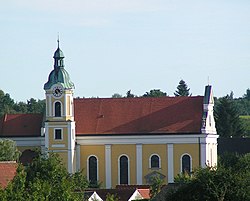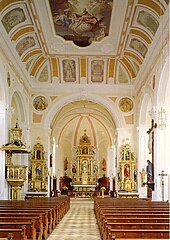St. Nikolaus (Siegenburg)
| St. Nicholas | |
|---|---|
| Denomination : | Catholic |
| Patronage : |
Nikolaus and Sebastian |
| Consecration year : | 1894 |
| St. Nicholas : | 1 |
| Cardinal Deacon : | 1 |
| Parish : | Siegenburg |
Coordinates: 48 ° 45 ′ 14.4 " N , 11 ° 50 ′ 59.9" E
The Roman Catholic parish church of St. Nikolaus in Siegenburg in the Lower Bavarian district of Kelheim was built in the years 1892 and 1893 in the neo-baroque style and consecrated to St. Nicholas . Due to its size and its prominent location on a hill above the Siegbach and the Abens, it is also known as the “Hallertau Cathedral”.
history
The original St. Nicholas Church in Siegenburg was rebuilt in late Gothic style after the devastation of the Landshut War of Succession in 1504 and withstood four market fires due to its prominent hillside location . In the 17th or 18th century, the church was presumably redesigned in baroque style, which may have been the decisive factor in favor of the neo-baroque variant for reasons of continuity when it was rebuilt in the 1890s . After the population had increased significantly, an extension of the church to the west was initially discussed from the 1860s and finally a much more spacious new building was decided in 1890 while retaining the church tower from 1816. This solution was obvious, especially since the cemetery was only moved away from the vicinity of the church in 1882.
The new building was built according to plans by the Munich architect Joseph Elsner in the neo-baroque style. Andreas Haberstroh from Siegenburg acted as the builder. After the foundation stone was laid on August 21, 1892, the building was completed in little more than a year, so that the first service could be celebrated at Christmas 1893. The consecration by the Regensburg bishop Ignatius von Senestrey took place on July 18 and 19, 1894. The painting of the ceiling of the nave and the room shell was not carried out until 1925 by the Munich painter Josef Wittmann . For the centenary, the church was extensively renovated inside and out in 1993 and 1994.
description
architecture
The church is a rectangular gable roof building with a western triangular gable and a recessed eastern choir . The exterior is structured by pilasters and high, arched window openings. The tower attached to the foremost nave yoke to the north is a short distance from the nave , but is structurally connected to it. Since the tower was taken over from the previous building, it seems rather too small compared to the rest of the church. The baptistery , also consecrated to St. Nicholas, is built into the corner between the choir and the tower, and the sacristy is built onto the south side of the choir . To the north of the tower is the Lourdes Chapel , which was built at the same time as the parish church and is of course also in neo-baroque style.
From inside the temple as a generous presents hall structure with high flat ceiling , whereby the wide space by pilaster with aisle-like passages in five yokes is divided. The transition to the flat slab is made via a chamfer . The chancel, which is closed on three sides, is spanned by a barrel vault, which looks like a canopy thanks to the girdle arches rising from the wall pilasters . The church is sparingly decorated with geometric stucco .
Furnishing
The interior was also planned by Joseph Elsner and created in his Munich “Institute for Christian Art”. The high altar and the two side altars contain elaborate ornamental carvings and rich gilding . Particularly valuable carvings are the apostle figures in the altar house and the tableaus to the left and right of the altar. They were carried out by Elsner's student Thomas Buscher , who later went into business for himself as a sculptor. Altars , tabernacles and the pulpit of the same style are richly decorated with sculptures and reliefs. Also noteworthy are the windows decorated with ornate stained glass .
The high altar is stylistically reminiscent of early Baroque altars and, thanks to its storey structure, shows parallels to its counterpart in Munich's Michaelskirche . For example, the towering gold tabernacle, which shows Christ on the cross in a central position, is striking. Below are the little doors with symbols for bread and fish, above a pelican , who picks up its own breast, as a symbol of the sacrificial death of Christ. The altar level above the tabernacle shows three figures of saints, each arranged under a round arch : in the middle the church patron Nicholas , on the left Saint Catherine , on the right Saint Barbara . Two richly decorated columns carry the next higher floor, so to speak, on which a picture of the Holy Family is flanked by two angels seated on volute cornices . Above this is an ornamented cornice below a medallion that is supposed to represent God the Father. The upper end of the high altar is a so-called sun of grace with the Christ monogram IHS . The popular altar and ambo were created in 1989 and are based on the column motifs of the high altar.
The also very artistic side altars are similar to the high altar and are also richly decorated. The right side altar is dedicated to St. Sebastian , the left is a Marian altar . The massive, elaborately designed pulpit is on the first wall pillar of the nave on the left. On the body there are figures of the four evangelists , on the underside of the sound cover a dove as a symbol for the Holy Spirit and on the back wall a relief of Christ as a teacher. On the opposite wall pillar is a cross with Christ, underneath the Virgin Mary. The way of the cross in stone gray reliefs by Sebastian Osterrieder , a well-known sculptor from nearby Abensberg, is interesting .
The ceiling and wall paintings in the church were made by Josef Wittmann in 1925. On the flat ceiling in the nave there are two large frescoes depicting the glory and sermon of St. Nicholas. In the front area you can see the advocacy and protection of the church patron for the market in Siegenburg, backwards Nikolaus preaches at the Council of Nicaea as one of the most influential representatives against the teaching of Arius , who denied the equality of Jesus with God. In the groove, Wittmann painted 20 symbols from the Lauretanian litany between gold-ocher brocade strips . The church fathers are depicted in the round spandrels between the pillars and on both sides of the choir arch .
organ
The organ of the parish church was built around 1940 as Opus 472 by Michael Weise from Plattling . The instrument with pneumatic performance and stop action comprises a total of 21 stops on two manuals and pedal . The windchests are so-called pocket drawers . The disposition is as follows:
|
|
|
|||||||||||||||||||||||||||||||||||||||||||||||||||||||||||||||||||||||||||||||||||||||||||||||||||||||||||||||
- Coupling : normal coupling II / I, I / P, II / P; Upper octave coupler II / I; Sub-octave coupling II / I
- Playing aids : MF, Tutti, shutter release, automatic piano pedal, pipe works
Peal
In Siegburger steeple is a five-part cis minor -Geläut whose tone sequence cis 1 -e 1 -fis 1 -GIS 1 -h 1 is, and only a soloist tolled death bell . This is already the third generation of bells on the Siegenburg church tower built in 1816. Three bells - the death bell from 1612, the small bell from 1767 and the middle bell from 1770 - could be taken over from the old tower. However, since the new tower had a higher load-bearing capacity , a fourth bell - with a weight of 18 quintals - was to form the big bell for this ringing - was commissioned from a foundry in Ingolstadt . This first bell had a total weight of 37 quintals. In 1917 the big bell was called up for war purposes, so a new bell was purchased in 1921. The small and medium bells were made available to the operating bell foundry Hamm from Regensburg as remelting material, while the death bell from 1612 was retained. The new five-part bell had a total weight of 68 quintals. As early as 1941 five bells were drawn in again, only the smallest bell from 1921 remained in the Siegenburg population. The death bell was the only one of the five confiscated bells to be returned intact in 1948. A year earlier, five new bells had been ordered from the Johann Hahn bell foundry in Landshut and the smallest bell from 1921 was made available as remelting material. All of these five bells bear the inscription: Joh. Hahn & Sohn Landshut / Reichenhall poured me out in 1947. The sixth and smallest bell of the peal is still the death bell , which was cast in 1612 by Georg Schelchshorn from Regensburg and which survived both world wars. The bells in detail:
| No. | Surname | Casting year | Caster | Weight [kg] | Diameter [cm] | Chime | inscription | Reliefs |
|---|---|---|---|---|---|---|---|---|
| 1. | Nicholas bell | 1948 | Johann Hahn, Landshut | 1,500 | 140 | cis 1 | Deliver us Lord from plague, hunger and war at the intercession of St. Nicholas. | St. Nicholas, St. Barbara , St. Catherine |
| 2. | Trinity Bell | 900 | 118 | e 1 | Glory be to the Father and the Son and the Holy Spirit. | Holy Trinity, St. Petrus Canisius | ||
| 3. | Mother of God Bell (consecrated to the Patrona Bavariae ) |
575 | 103 | f sharp 1 | Dear Mary with the child, give us all your blessings. | Patrona Bavariae, St. Josef , brother Konrad | ||
| 4th | Sacred Heart Bell | 400 | 92 | g sharp 1 | Heart of Jesus, atonement for our sins, have mercy on us. | Sacred Heart of Jesus, John the Baptist , St. Anthony of Padua | ||
| 5. | Sacrament bell | 250 | 77 | h 1 | Tantum ergo sacramentum veneremur cernui. | Chalice, St. Sebastian, St. Aloisius | ||
| 6th | Death bell | 1612 | Georg Schelchshorn, Regensburg | 68 | 44 | c 3 | 1612 from fire I flowed. Georg Schelchshorn from Regensburg poured me. I sound and hang / you sing and thank God / all your life. |
Cross, risen Christ with victory flag |
literature
- Sixtus Lampl : Parish Church of St. Nikolaus in Siegenburg - "The Hallertau Cathedral". Leaflet. Schlossverlag Valley, 2008.
- Dehio , Bavaria II: Lower Bavaria. P. 664
Web links
- Internet presence of the parish of Siegenburg
- Information about the parish of Siegenburg on the website of the market town of Siegenburg
Individual evidence
- ↑ a b c d e Parish Siegenburg: Parish Church of St. Nicholas . Online at www.pfarrei-siegenburg.de. Retrieved July 18, 2016.
- ↑ a b Parish Church of St. Nicholas . Online at www.siegenburg.de. Retrieved July 18, 2016.
- ↑ a b Sixtus Lampl : Parish Church of St. Nikolaus in Siegenburg - "The Hallertau Cathedral". Leaflet. Schlossverlag Valley, 2008.
- ↑ Markt Siegenburg: The organ in the parish church . Online at www.siegenburg.de. Retrieved July 17, 2016.
- ↑ Markt Siegenburg: The bells on the church tower of the parish church of St. Nicholas . Online at www.siegenburg.de. Retrieved July 17, 2016.
- ^ Siegenburg, Parish Church of St. Nicholas . Online at glockenklaenge.de. Retrieved July 17, 2016.


